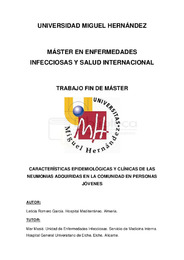Resumen :
La neumonía adquirida en la comunidad (NAC) es una enfermedad muy prevalente que genera un importante gasto sanitario. Los estudios llevados a cabo se han realizado sobre todo en niños y ancianos. Las escalas pronósticas, validadas hasta ahora, dan mucho peso a la edad, por lo que el riesgo en los pacientes jóvenes puede estar subestimado. Por esta razón nos propusimos estudiar las características clínico epidemiológicas de esta enfermedad en una población joven, comparándola con una población mayor; para investigar diferencias que faciliten el manejo terapéutico. Se realizó un estudio transversal prospectivo de una muestra de 795 pacientes divididos en 2 grupos: de 14 a 35 años (n=278) y mayores de 35 años (n=517). Se compararon las comorbilidades, aislamientos microbiológicos, tratamiento y evolución clínica entre ambos grupos. En los pacientes con NAC, la mayoría de las comorbilidades y pluripatología se relacionaron con la edad. La edad no se asoció con mayor riesgo de fracaso terapéutico ni necesidad de hospitalización en los pacientes manejados de forma ambulatoria. Tampoco hubo diferencia respecto a la mortalidad en ambos grupos. Azitromicina fue el antibiótico predominante en los pacientes jóvenes y el levofloxacino se prescribió con más frecuencia a los de mayor edad, con similar resultado. La Legionella p. se detectó mayoritariamente en los pacientes de mayor edad, mientras que el S. pneumoniae se presentó en una proporción similar en ambos grupos de edad.
Background: Community-acquired pneumonia (CAP) is a very prevalent
disease that generates significant health expenditure. The studies have been
carried out mainly on children and the elderly. The prognostic scales, validated
until now, are very important to age, so the risk in young patients may be
underestimated. For this reason, we decided to study the clinical epidemiological
characteristics of this disease in a young population, comparing it with a larger
population; to investigate the differences that facilitate the therapeutic
management.
Methods: transversal prospective study of a sample of 795 patients divided into
2 groups: 14-35 years (n = 278) and over 35 (n = 517). Comorbidities,
microbiological isolates, treatment and clinical evolution were compared between
the two groups.
Results: The presence of comorbidity was analyzed in 378 patients: 151 ≤35
years and 227> 35 years, evidencing statistical association to the older group
(OR: 0.285; CI: 0.143-0.569; p <0.001). Statistically significant differences were
found in hypertension (p <0.001), smoking (OR: 0.237, CI: 0.097-0.723, p =
0.007) and diabetes (OR: 0.95; CI: 0.012-0.734) associated with as did
pluripathology (p <0.001). There were no differences in the clinical evolution of
outpatients or hospitalized patients. The levels of procalcitonin (PCT) were
analyzed without finding significant differences (p = 0.87). The presence of
Legionella pneumophila antigen was associated with the older age group (p=
0.014, OR: 0.119; CI: 0.16-0.906) whereas for Streptococcus pneumoniae there
were no differences. Azithromycin was the predominant treatment in the young
(p = 0.01), while levofloxacin was associated with the elderly (p = 0.013), with no
difference in satisfactory outcome with both antibiotics (p = 0.460). Conclusions: In patients with CAP, most of the comorbidities and pluripathology
were related to age. Age was not associated with an increased risk of therapeutic
failure, hospitalization in those who had been operated on an outpatient basis.
There were also no mortality differences in both groups. Azithromycin was the
predominant antibiotic in young patients and levofloxacin was associated with the
oldest, with similar outcome. The Legionella p. was detected mostly in older
patients, whereas S. pneumoniae was present in a similar proportion in both age
groups.
|
 La licencia se describe como: Atribución-NonComercial-NoDerivada 4.0 Internacional.
La licencia se describe como: Atribución-NonComercial-NoDerivada 4.0 Internacional.
.png)
